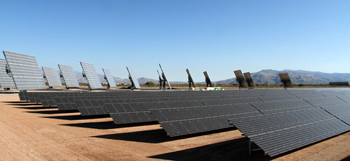Get in the Zone: Solar Zone Delivers Latest in Renewable Energy Research
 TUSCON, Ariz. — If solar power, photovoltaic arrays and renewable energy are your idea of fun, then welcome to your playground at the University of Arizona’s (UA) Solar Zone in Tucson, Ariz.
TUSCON, Ariz. — If solar power, photovoltaic arrays and renewable energy are your idea of fun, then welcome to your playground at the University of Arizona’s (UA) Solar Zone in Tucson, Ariz.
Solar Zone is located at the UA Tech Park and serves as a primary research facility for solar energy. The first-of-its-kind solar-centric research park includes power generation by multiple technologies; research and development; manufacturing and distribution of solar equipment and hardware; green-job and workforce training; educational outreach; and a public demonstration and awareness hub.
Solar Zone has taken nearly three years to create, from initial design concept to final construction. The last few projects in the Solar Zone are slated for completion at the end of this year. However, the actual UA Tech Park isn’t new to the area, as it has been around for nearly 17 years — after the University of Arizona purchased the land from IBM, it has grown from two tenants and 1,200 employees to 50 companies and business organizations with 7,000 employees. The park also contributes nearly $3 billion annually to Pima County’s economy and is one of the region’s largest employment centers, according to the University of Arizona.
The entire park has approximately 1.9 million square feet of high-tech office, research and development, and laboratory space. The entire park is more than 1,300 acres and leases land to operators and then sells the power to Tucson Electric Power (TEP), the city’s leading power utility company.
The UA Tech Park is the largest multi-technology solar evaluation site in the U.S., and all solar power generated in the Solar Zone is used by TEP to expand its renewable energy resources in Southern Arizona. TEP also owns and operates the Solar Zone’s first installed system, a 1.6 MW single-axis tracking photovoltaic system, according to the University of Arizona.
Companies from around the world come to the Solar Zone to test the latest renewable products before marketing them for distribution. Companies lease the land from Tech Park to perform research and testing and then sell the power to TEP.
“By creating Solar Zone at the UA Tech Park, we’ve created a research park within a research park,” said John Grabo, director of business development for the UA Tech Park and Solar Zone project leader.
“Companies come and install, maintain, and operate their products at the park. They are essentially right next door to another company and their product,” explained Grabo. “The Solar Zone is an outdoor learning laboratory.”
The Solar Zone is broken down into two phases: Solar Zone 1.0 and Solar Zone 2.0. Solar Zone 1.0 is near completion and has 165 acres dedicated to energy storage and research into heat-island impact.
Solar Zone 2.0 is currently marketing to the industry and plans to use the remaining 56 acres within the Solar Zone to house companies responsible for developing the latest renewable energy products and installations.
“We want to use Solar Zone 2.0 as a place where companies can go and figure out where the industry is going,” Grabo said.
Solar Zone 2.0 will be built to help spur renewable research development. The future of any industry is relatively unclear, but Grabo predicts the Solar Zone will be a good testament of what is to come in the industry.
“I think the industry is always evolving, and creating smaller panels seems to be the future of renewable energy,” Grabo said.
New Installations
The park welcomes new concepts and innovations in the renewable energy industry, including a new design inspired by the telescope that could produce nearly twice the energy as standard solar installations.
The new solar panel module uses a curved mirror to focus sunlight onto a 5-inch glass ball that then spreads the light evenly across a solar panel, leading to twice the power output of traditional solar panels when combined with high-efficiency solar cells, according to researchers at the park.
The design has been used in the past, but not on this planet. The design was inspired by solar panels used by space agencies. The solar cells capture a wider range of the solar spectrum than regular cells, leading to the increase of energy.
Tucson, Ariz.-based company, REhnu is in charge of the design and installation of the new solar panel module. While the system is working, it also radiates high temperatures so researchers designed a cooling system composed of fans and a radiator that keeps the array within 36 degrees of the outdoor temperature, which can be almost unbearable in the summer months.
The heat is not all that bad though, according to researchers, they are working on a way to use the mirrors to create an eco-friendly furnace that works like a toaster oven to burn a mold into a flat sheet of glass.
The research has shown that with a solar tracker featuring two mirrors, the system can generate enough energy to power two homes, but researchers hope to include eight mirrors on each module.
Although UA Tech Park officials are currently focusing on Solar Zone 2.0, that’s not to say they won’t continue to expand the Solar Zone in the future.
“We have over 1,300 acres on the whole campus, so it’s definitely not a challenge to find space,” Grabo said. “We’re proud to be the place where renewable energy researchers turn to, and Solar Zone 2.0 will welcome in even more of the latest technologies.”
